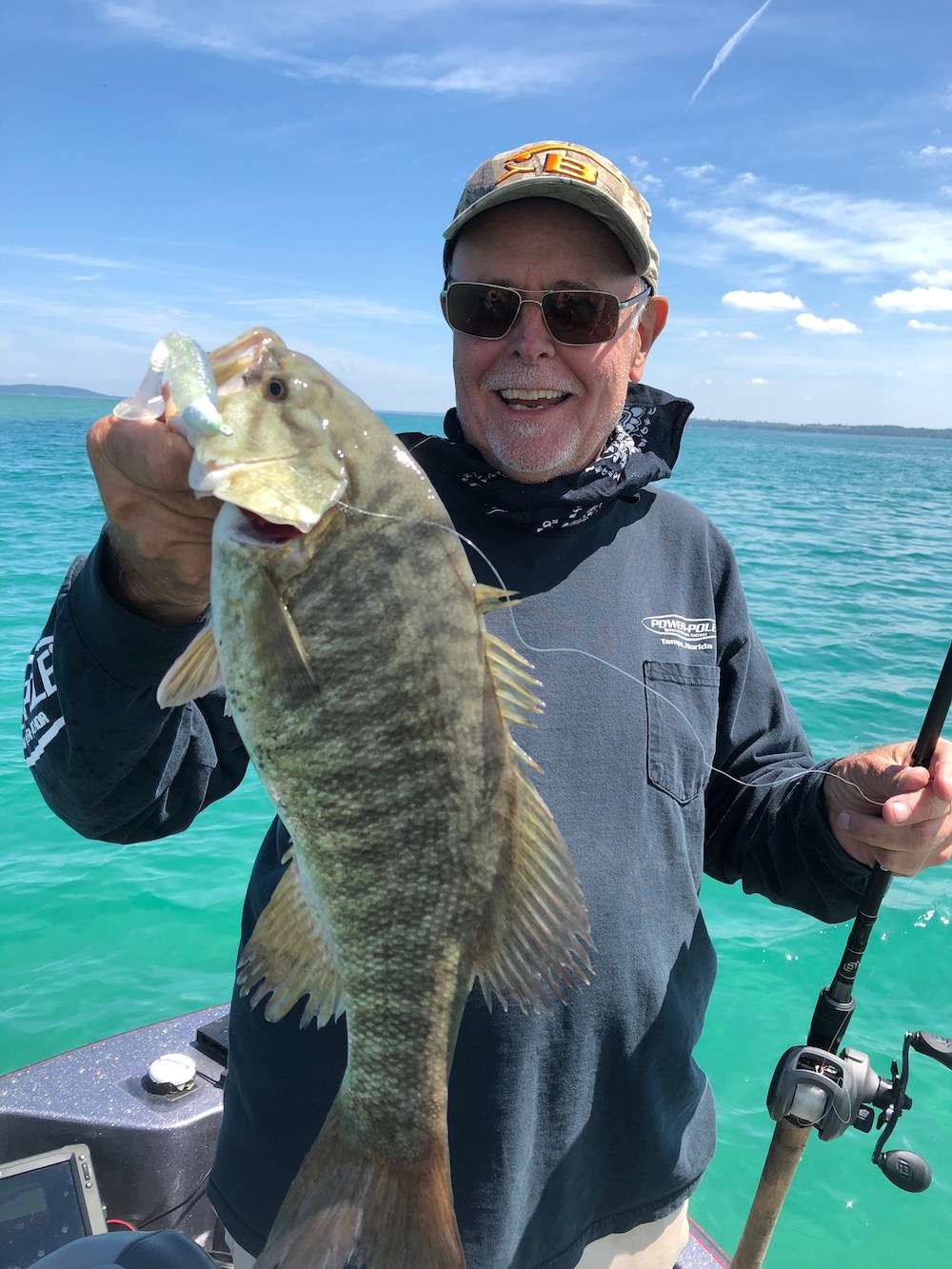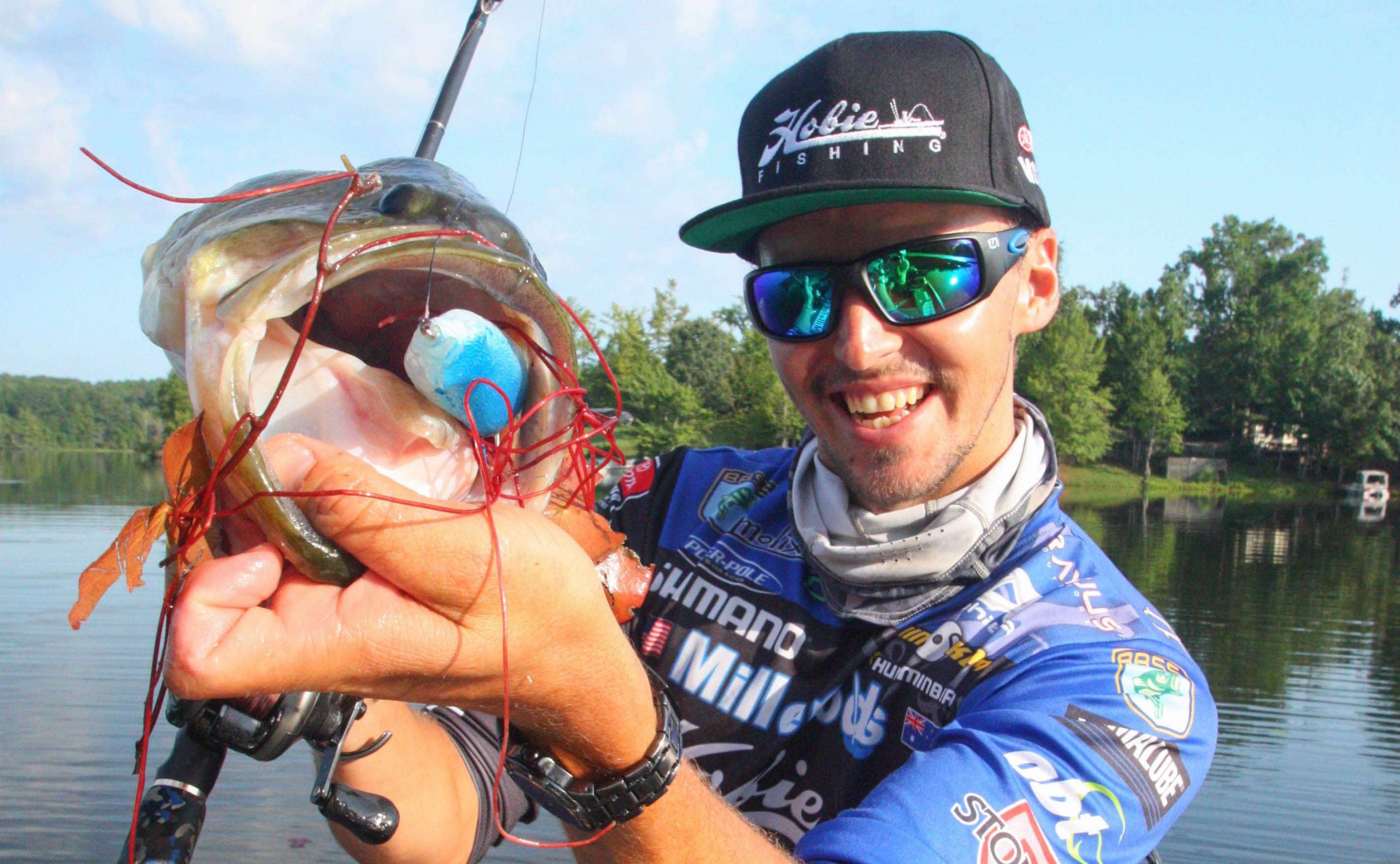
It seems appropriate to feature former Elite Series pro Carl Jocumsen in the Best Bass Lakes issue of Bassmaster Magazine. After all, he honed his bass fishing skills for over a decade in his homeland of Australia before traveling to the U.S. to make his mark on professional bass fishing. So, here you will get to see how techniques and tactics for catching green fish down under translates stateside.
7 HOURS LEFT
6:45 a.m. We launch the Bass Cat. Jocumsen checks the lake temp: 83 degrees. What pattern does he foresee being operative today? “Summer bass normally relate to deep structure and shallow vegetation. I’ll need to take a tour of the lake to check out those options, but I want to first try some topwater before the sun burns off the fog.” As Jocumsen pulls an assortment of Miller rods equipped with Shimano reels from storage, I ask him about the bass fishing scene in his native Queensland. “I competed in Australian bass tournaments for 10 years before moving to the States. The Australian bass is totally different from the American largemouth; a really big one weighs about 5 pounds. Australia is best known for its amazing saltwater fishing, but there are many exciting freshwater species there, including the Murray cod, which can weigh over 100 pounds. The various species I targeted back home all required different lures and tactics; this combined experience helped me adjust to American bass fishing surprisingly quickly.”
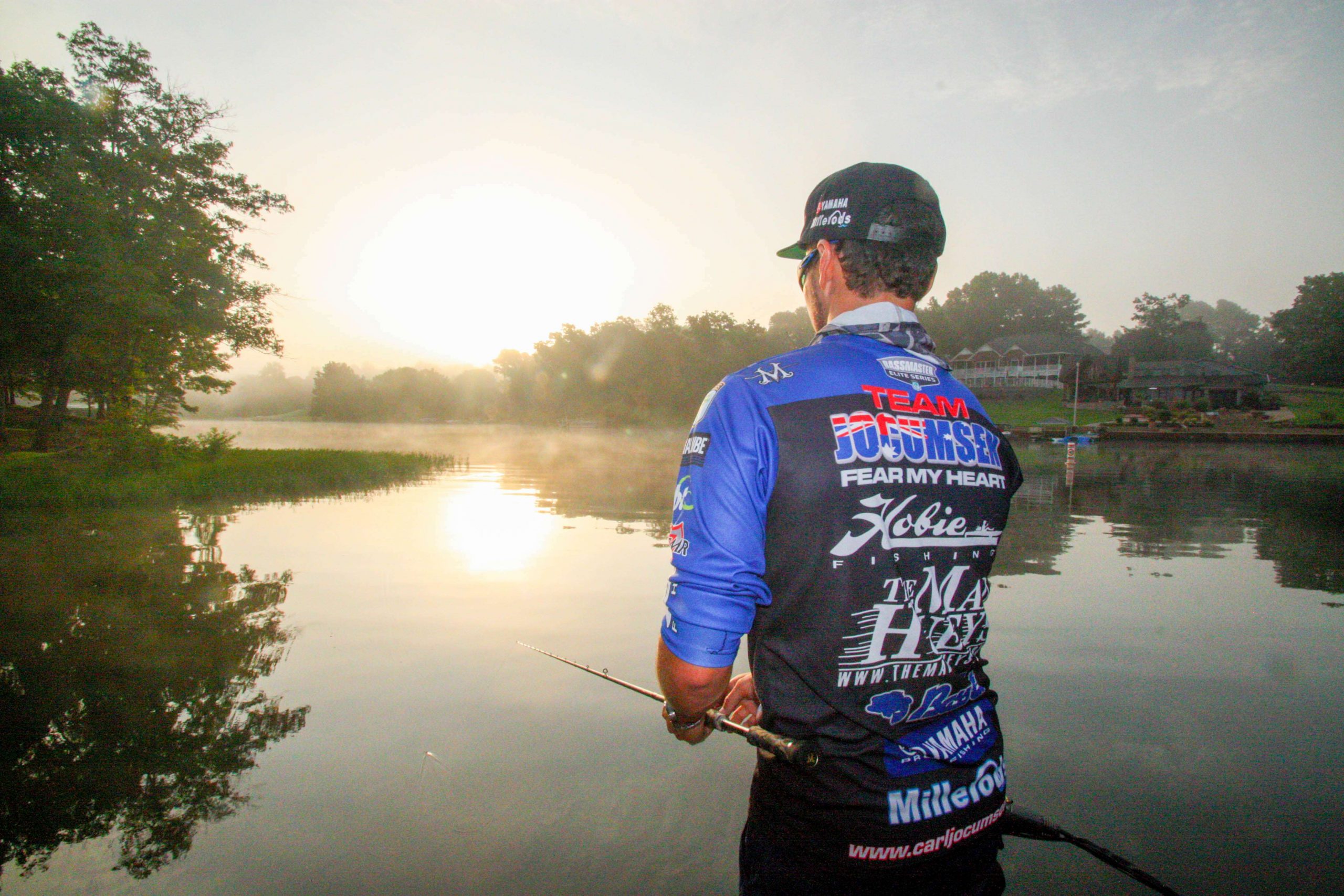
6:53 a.m. Jocumsen idles to a nearby shoreline and makes his first casts with a bone colored Reaction Innovations Vixen topwater stickbait.
7:03 a.m. Jocumsen ties on a blue and white Molix WTD weedless surface rat. He retrieves the buoyant lure through a patch of emergent grass, then pauses to squeeze water from its soft, hollow body.
7:15 a.m. He switches to a shad colored 3/4-ounce Bassman spinnerbait with a Molix swimbait trailer. “I’ve won a load of money back home on this Australian lure; it’ll catch anything that swims and is ideal around deep docks like the ones on this bank.”
7:24 a.m. Jocumsen moves to Lake L’s dam and tries a Molix RA Shad, a small swimbait with a 3/8-ounce head and a belly spinner. A bass bumps the lure as he retrieves it out from the riprap.
7:33 a.m. Jocumsen tries a purple pumpkin 3/8-ounce Molix jig with a craw trailer around the riprap. “I’m seeing a few fish on my electronics, but they’re really scattered.”
6 HOURS LEFT
7:52 a.m. Jocumsen rockets uplake to a tributary arm, where he finds an abundance of pad cover. He begins casting the weedless rat to the vegetation, shaking his rod tip while reeling to dog-walk the lure across the cover. “The water up here is just 78 degrees, so the fish should be active.”
8 a.m. As Jocumsen retrieves the rat across some pads into open water, a bass sucks it under but doesn’t hook up. “That was a good fish!”
8:07 a.m. Jocumsen bags his first keeper of the day, a 1-pound, 4-ounce largemouth, from the pads on the rat. “This skinny guy was way back in there. If he’d been eating properly, he’d weigh 3 pounds!”
8:10 a.m. Jocumsen resumes casting the rat to the pads. “I’m all about a stealthy approach, and when fishing pads, I’ll move to the spot I want to fish with my trolling motor on low, then wait to cast until the boat is sitting still. Besides being less obtrusive, this keeps my line dead straight during the retrieve instead of in an arch, which guarantees more hookups because there’s less slack.”
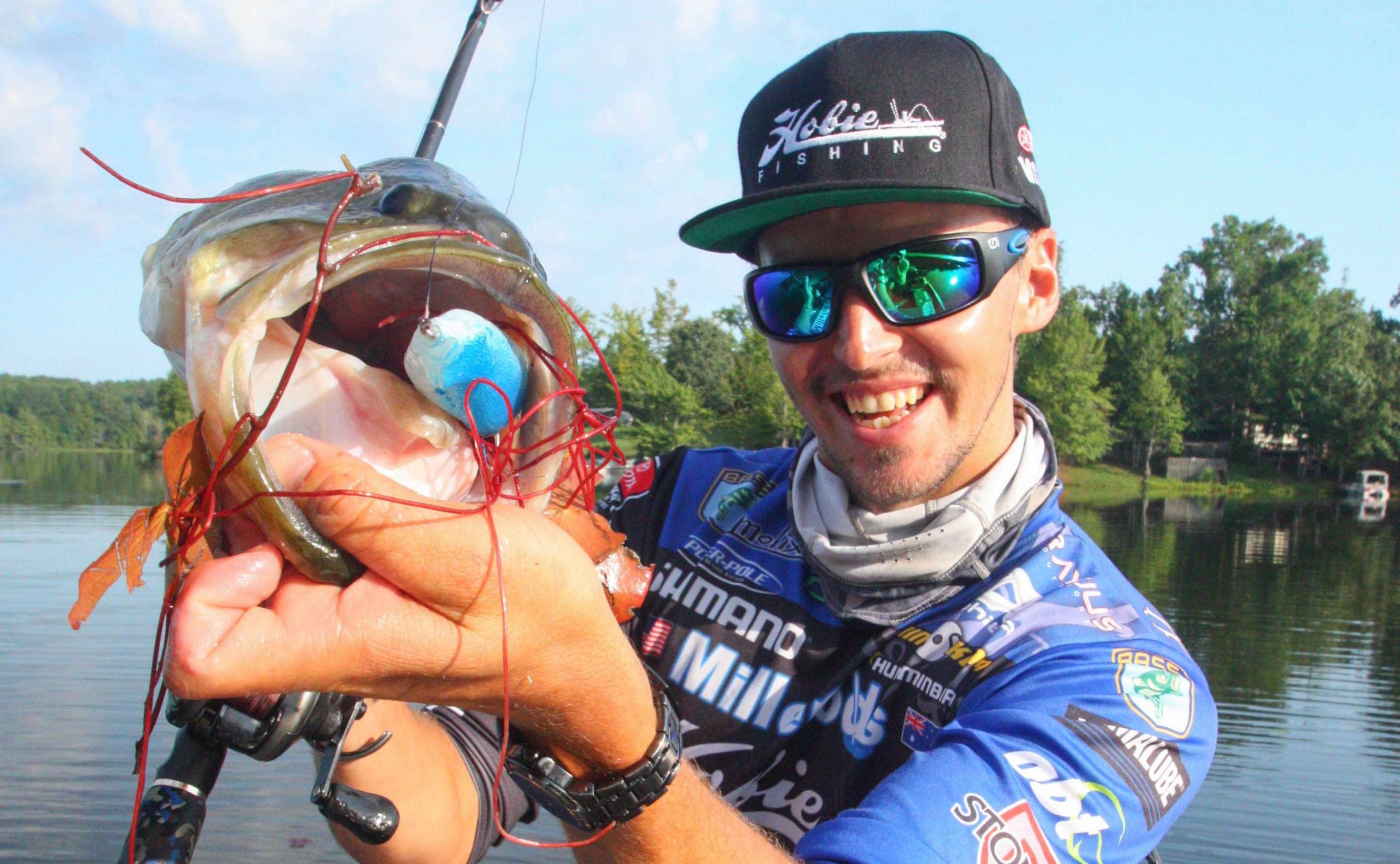
8:13 a.m. Jocumsen gets a solid strike on the rat. He leans on the fish to get it on top of the pads, then swings aboard his second keeper, a fine 4-pound, 15-ounce largemouth. “All right, mate! This fish was on the edge of an isolated clump of pads. I’ve learned that 5-pounders don’t lie, so I’m going to keep hitting the pads because I have confidence that more big fish are in this cover.”
8:18 a.m. Jocumsen is methodically walking the rat over the pads. He’s using a 7-10 frog rod with an 8:1 reel and 50-pound braided line.
8:30 a.m. A lunker bass swirls on the rat; Jocumsen swings and misses. “Did you see that? Its head came all the way out of the water!”
5 HOURS LEFT
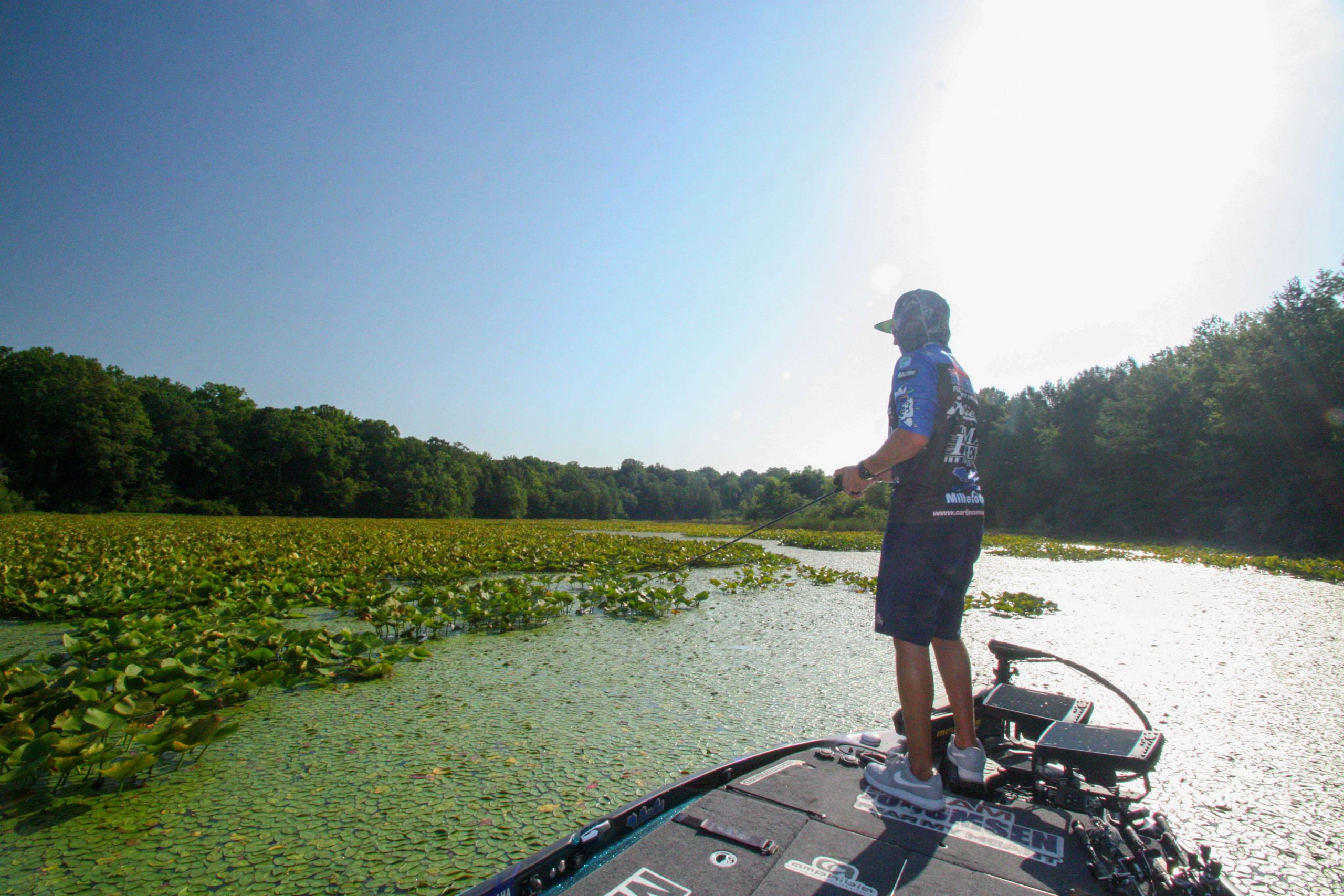
8:47 a.m. Jocumsen moves 50 yards to a spot where larger pads mix with the small “dollar” pads he’s been fishing.
8:55 a.m. “There’s less activity the deeper I move into the pads,” Jocumsen observes. “I’m going to key on pads nearest to the entrance of this creek arm.”
9:11 a.m. Jocumsen approaches the opposite shoreline of the creek entrance. “The bank looks deeper there, and there are some laydowns mixed in with the pads.”
9:20 a.m. I complain about the oppressive heat and humidity as Jocumsen continues probing the pads, but he just laughs. “Compared to Queensland, this is like being in air conditioning!”
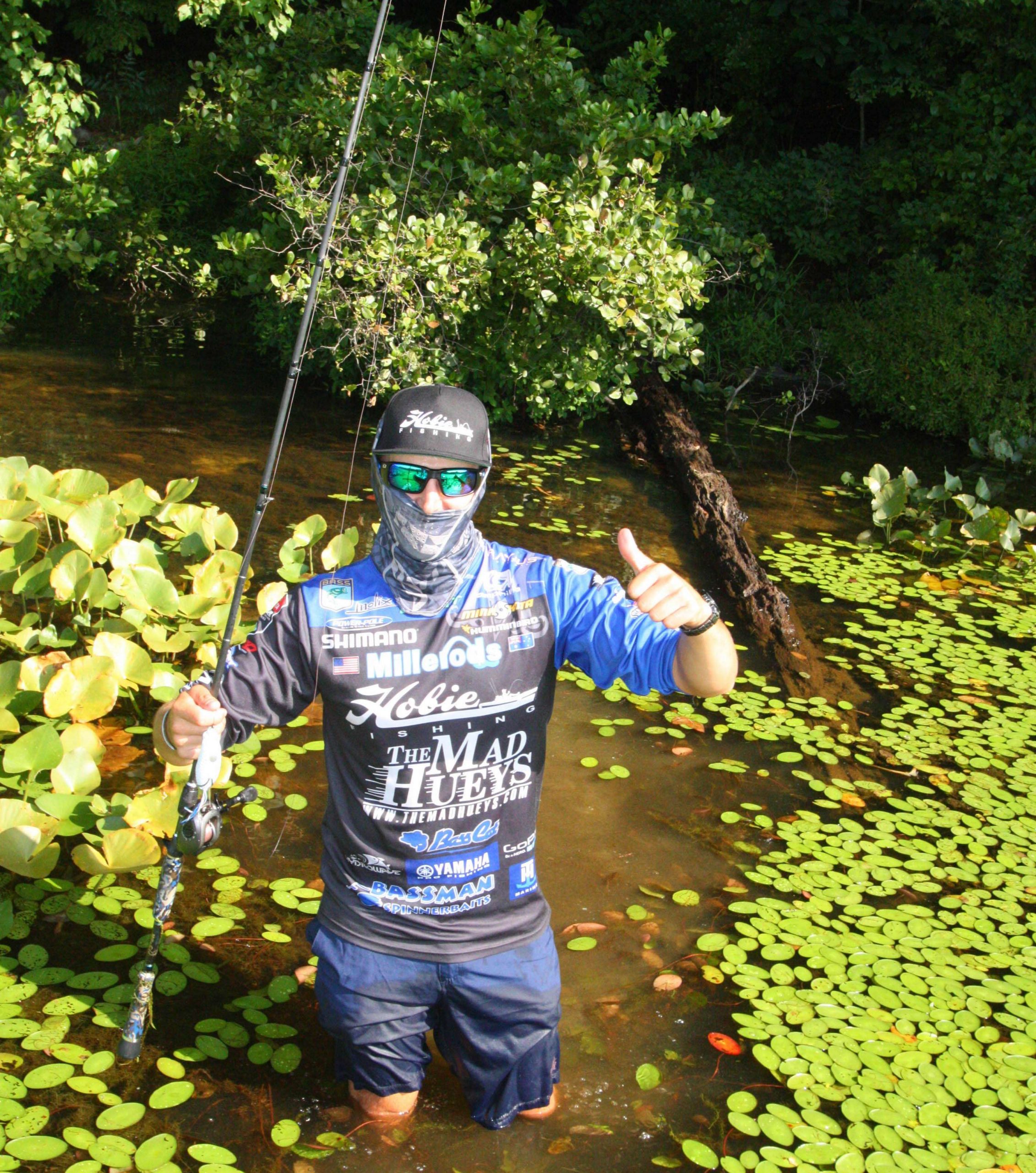
9:24 a.m. Jocumsen casts the frog to a shoreline log. Its hooks hang in the laydown; repeated rod shakes fail to pop it free. “I’ve only got two of these lures, so I’m going in after it!” He jumps into the lake, wades to the log and pulls the lure free. “I wouldn’t risk doing this in Australia, what with all the crocs and snakes!”
9:32 a.m. Continuing past the pads, Jocumsen retrieves a bluegill colored 3/8-ounce Bassman swim jig with a generic paddletail trailer around a laydown tree.
4 HOURS LEFT
9:45 a.m. Jocumsen heads straight across the creek mouth while swimming the jig around the edge of the pads.
9:52 a.m. He swims a crystal shad 3/8-ounce Bassman bladed jig with a Molix RA Shad trailer across the hydrilla. A 5-pound bass shoots out of the grass and nips the lure’s trailer. “Wow, that was a good fish!”
10:04 a.m. Back where he caught his two keepers, Jocumsen resumes walking the rat across pads.
10:16 a.m. Jocumsen vacates the tributary and moves to an isolated patch of pads on the main lake. Some cloud cover is starting to move in as he tries the rat.
10:26 a.m. Jocumsen Texas rigs a Reaction Innovations Sweet Beaver creature in the California 420 color on a stout flipping hook with a 1-ounce pegged sinker, then proceeds to flip it into the hydrilla.
10:34 a.m. The pads are calling, so Jocumsen resumes casting the rat to the vegetation.
3 HOURS LEFT
10:45 a.m. This spot fails to pay off, so Jocumsen moves a quarter-mile downlake to another stand of water lilies, which he hits with the rat and the swim jig. Storm clouds are building up around us and thunder rolls in the distance.
10:49 a.m. He swims the bladed jig across the top of a submerged hydrilla bed. “I can’t believe I’ve only seen one fish around this grass.”
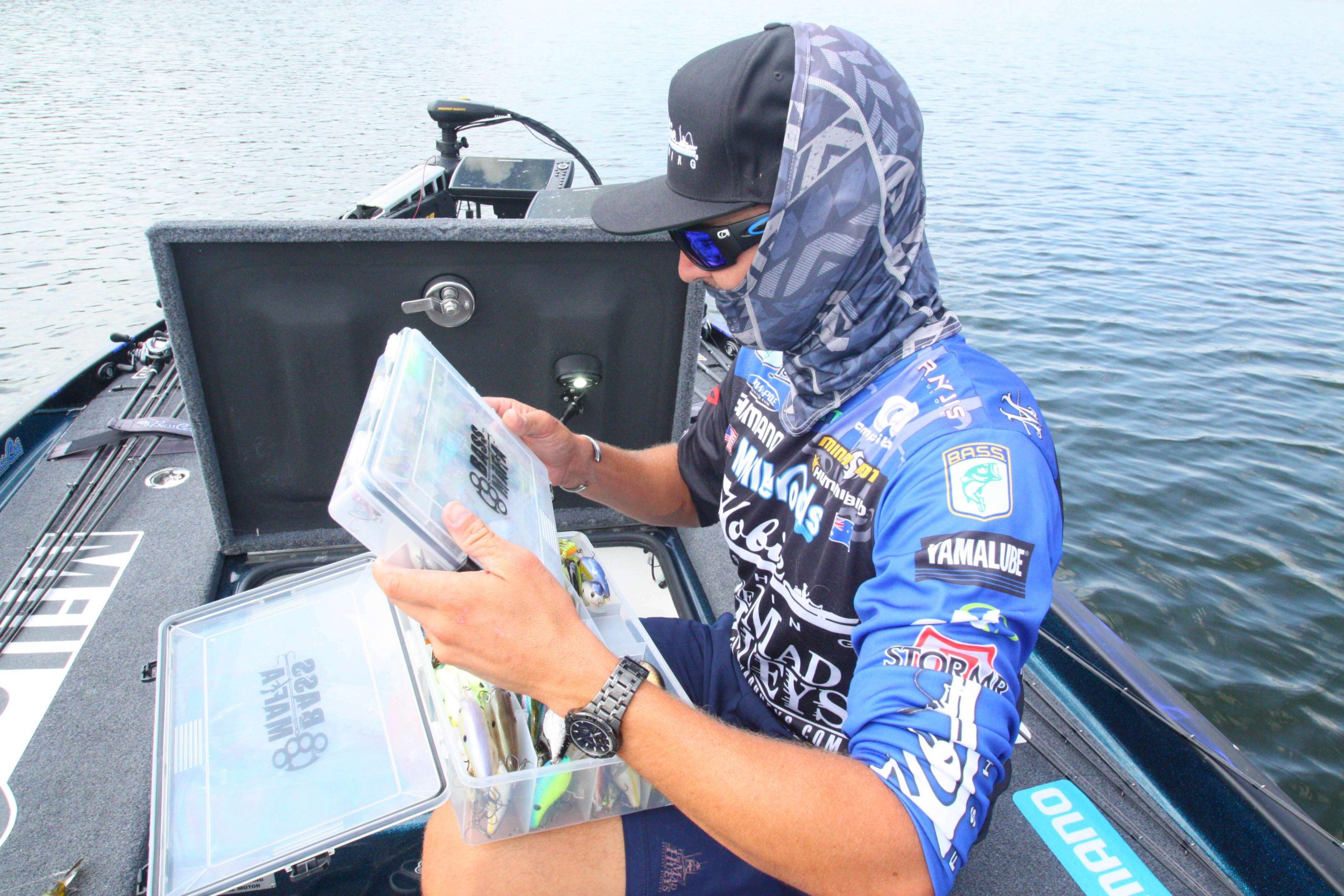
11:02 a.m. Jocumsen decides to shift gears and fish a nearby main-lake point. The structure is shallow on top, studded with stumps and dropsoff into 16 feet on either side. He pulls out several crankbait boxes and selects a crawfish Molix Sculpo deep diver.
11:14 a.m. Jocumsen opts to try a finesse worm off the point. He rigs a Roboworm in the margarita mutilator color on a No. 1 drop shot hook, attaches a 12-inch drop line with a 3/8-ounce sinker below the lure, then drags it across rocks on the bottom. He immediately detects a bite, tightens down on the fish and swings a nonkeeper aboard. “I’m seeing several fish on my electronics, and they don’t all look this small.”
11:17 a.m. A good fish picks up the Roboworm. Jocumsen sticks it momentarily, but it comes unbuttoned. “That one felt solid.”
11:20 a.m. Jocumsen catches a microbass on the Roboworm.
11:21 a.m. Another tiny bass eats the Roboworm. “I’m still seeing some big fish down there on my electronics.”
11:27 a.m. Having followed the point toward shore, Jocumsen switches crankbaits to a shad colored Lucky Craft 2.5 square bill and retrieves it parallel to the edge of the structure.
11:40 a.m. Back to the Roboworm on the point. A bass strips the worm off the rig.
2 HOURS LEFT
11:51 a.m. Jocumsen makes a short hop back to the pads where he caught his two keepers and drags the rat across the cover.
12:13 p.m. He rounds a point and begins casting the swim jig to a channel bank with scattered wood cover. “This spot is totally different than what I’ve been fishing, and there’s deep water close by.” Nothing here.
12:36 p.m. Jocumsen races to the extreme upper end of Lake L, where he fishes a submerged ditch with the drop shot worm.
1 HOUR LEFT
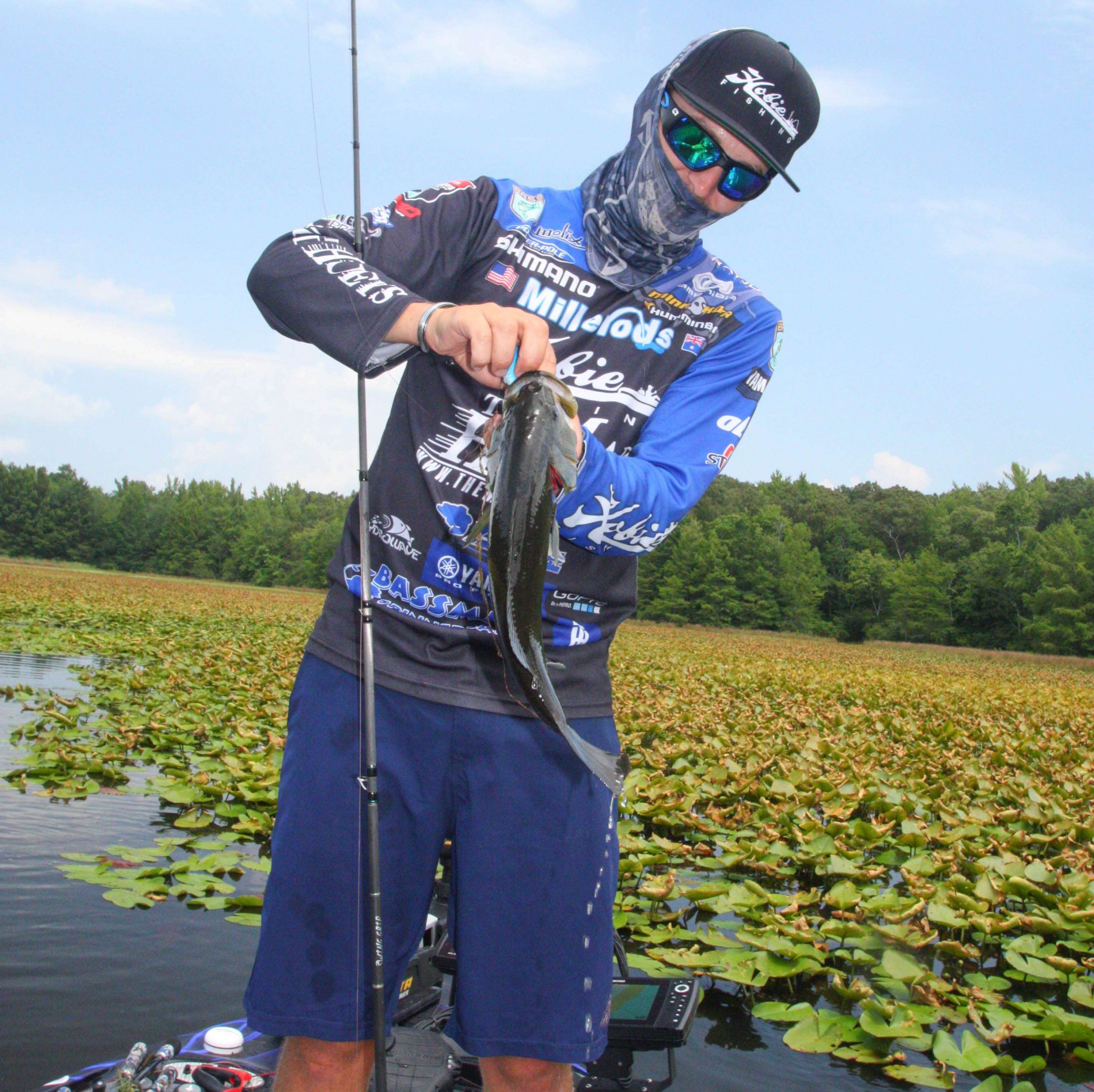
12:48 p.m. Jocumsen follows the ditch into a shallow pad-choked pocket. He casts the frog to the edge of the pads and catches his third keeper bass, 2 pounds, 2 ounces.
1:10 p.m. Jocumsen races downlake to a main-lake point. He hits it with the swim jig, spinnerbait and Roboworm.
1:17 p.m. Moving farther downlake, Jocumsen probes an offshore rockpile with the Roboworm. “There’s a load of fish here, but they’re all suspended.”
1:21 p.m. Jocumsen tries the underspin swimbait off the rockpile. “This usually works well on suspended fish.” But not today!
1:30 p.m. Jocumsen has returned to Lake L’s dam and is retrieving an 8-inch Megabass swimbait around the structure. “I’m going for the 12-pounder!”
1:45 p.m. Time’s up. Jocumsen ends his day on Lake L with three keeper bass totaling 8 pounds, 5 ounces.
THE DAY IN PERSPECTIVE
“I thought I was onto something when I caught that 4-15 out of the pads early, but I couldn’t get on any more big fish on that pattern,” Jocumsen told Bassmaster. “I had a lot more bites off deep structure than I did in the pads, but they were mostly from very small fish. Still, I didn’t move out deeper until 11 a.m., so I didn’t have much time left to locate more deep places that might have held bigger fish. If I were to fish here tomorrow, I’d head straight to those tributary pads and hit them hard until the bite tapered off, then I’d nose around offshore and look for more deep spots instead of re-hitting the pad fields that didn’t produce for me today.”
WHERE AND WHEN JOCUMSEN CAUGHT HIS KEEPER BASS
1. 1 pound, 4 ounces; blue and white Molix WTD weedless surface rat; lily pads near tributary mouth; 8:07 a.m.
2. 4 pounds, 15 ounces; same lure and place as No. 1; 8:13 a.m.
3. 2 pounds, 2 ounces; same lure as No. 1; lily pads in upper end; 12:48 p.m.
TOTAL: 8 POUNDS, 5 OUNCES

